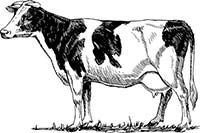Early Livestock ~ Index
Men who immported purebreed livestock into the Cache Valley, to improve the breeds. The Holstine dairy cow now the dominate breed in the valley.

Cache Valley with its large natural meadows, wild grasses and watered canyons offered the best of grazing lands. The early settlers therefore naturally took to livestock and began to raise cattle and horses and some sheep. Being progressive, they were always looking for something better and of course began to improve their herds.
President Brigham Young imported some purebred Durham and Devon bulls and placed them on the church farm in Cache Valley with other cattle. The Durham was the roan type, while the Devon was a dark red. These bulls were from a good milk strain and produced the foundation for a good milk stock in the valley. The cross with other cattle made splendid milk cows and it was not long until the settlers had a considerable milk production. Of course the many fine breeds of dairy and beef cattle we have at present did not exist or were not known at that time, as it has taken years of experience and work to produce the high standard of dairy and beef cattle we have today.
As early as 1866, Bishop Thomas Tarbet of the third ward of Logan, imported a purebred Durham bull. Bishop William B. Preston took an active interest in the cattle at the church farm and the livestock industry, especially with the Devon cattle. He was perhaps the first to import the Holstein breed in the valley.
The real pioneer of the Jersey cattle in the valley was Mr. John T. Caine of Logan. He and his sons and perhaps grandsons, have done more than any other group to build up a fine type of purebred Jerseys in this section of the state. In the very beginning, they always sought quality and by careful breeding, selection and care, they built up one of the best purebred Jersey herds in the intermountain states. Their stock has been sold in many parts of Montana, Idaho and Utah.
In March 1885, Mr. John T. Caine imported from Richardson Brothers, Davenport, Iowa, a yearling bull, Climas son of Combination, one of the noted sires in his day. Mr. Caine also imported at the same time a two-year old heifer, Jessie. In April, Jessie had a bull calf and it was sold to a man in Preston, Idaho.
In the spring of 1886, Mr. Caine purchased a four-month's old heifer calf, Crisba, a granddaughter of St. Helier and Dr. Ben Franklin, both prominent sires. In August of that year a bull, Inventor, and a yearling heifer, Ogontz, were purchased from the Richardson Brothers. Inventor was a double grandson of Combination, whose sons and daughters were readily sold. Ogontz was a daughter of Upright which had made a reputation of having eleven daughters make good butter tests. Ogontz was not an exceptionally good cow, but because of her breeding Mr. Hood purchased her with other cattle from the Pacific states and shipped them to the Hodd Farm, at Lowell, Massachusetts.
In 1887, Compete, a daughter of Combination, was purchased. She was a very promising heifer but later, calving in July, she bloated on alfalfa and died. Her daughter, Diagram was by Diploma, which was one of the sensational sires of the eighteen-eighties. Diagram had a heifer calf in May, 1889 and died a few months later. In 1898 another bull, Prince's Diploma, was purchased from the Richardson Brothers. This bull was kept in the herd for five years and was then sold to Joseph Merrill of Rich, Idaho. Since then Mr. Caine and his sons have continued to improve their herd of purebred Jerseys in the state and George W. Thatcher, of Logan, purchased two head from this herd.
The Holstein breed did not become so prominent in the valley until the establishment of the condensed milk factories. Today they are the dominant breed in this section and we have some of the finest herds to be found it the intermountain states, Richmond, more than any other town in the valley, has encouraged this breed and it has become the dairy center of the state.
Richmond is also the home of the famous Jersey herd owned by the Canine Livestock Company.